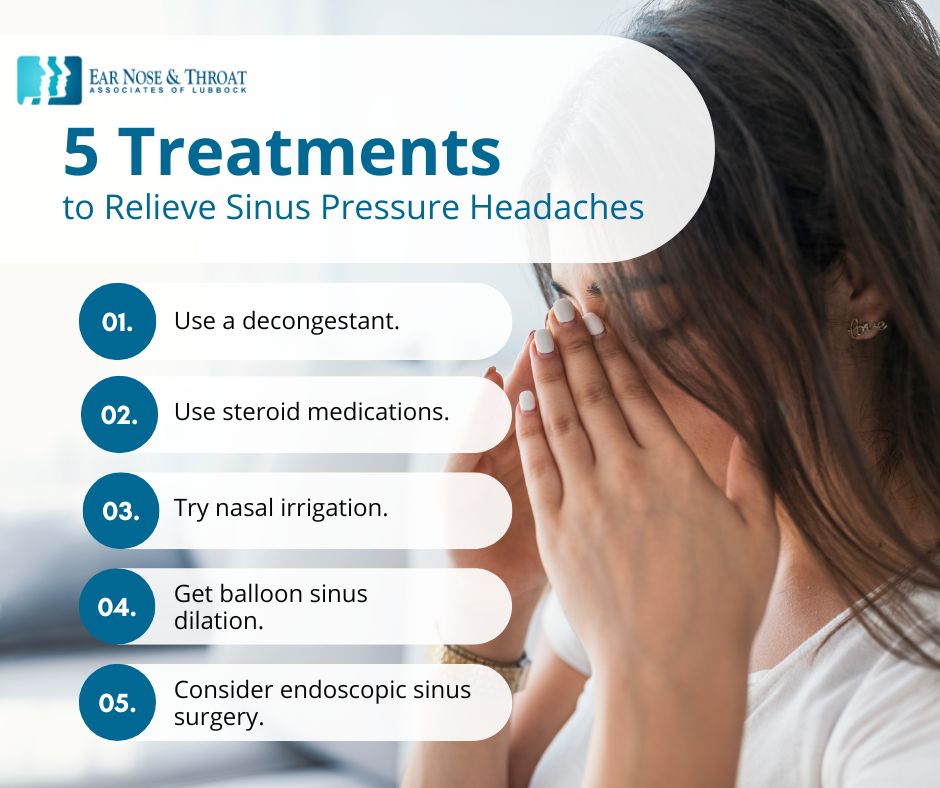How Sinus Pressure Headaches Happen (Plus What to Do)

You’ve probably experienced a headache before. Whether it’s a migraine, cluster headache, tension headache, or some other type of headache, none are pleasant.
Sinus pressure headaches are a common type of headache occurring in the face that many people live with for years because they don’t know there are long-term solutions. What if you could prevent sinus pressure headaches and avoid all the pain and discomfort in the first place?
Let’s look at what sinus pressure headaches are and explore five potential treatments to relieve their uncomfortable symptoms.
What Are Sinus Pressure Headaches?
Your sinuses are a series of connected air-filled cavities behind your cheeks, forehead, and nose. Sinus pressure headaches occur when the lining of your nose swells and obstructs your sinuses.
Typically, sinus pressure headaches start behind your eyes, forehead, or cheeks and radiate out, creating a feeling of fullness, pressure, and pain in the front of your face. Sometimes the pain can even radiate down into your teeth. Sinus headaches can also trigger other types of headaches, like migraines, causing a throbbing or pulsing sensation in your head.
Anything that causes swelling in the nose might cause a sinus headache, such as:
- Allergies
- A cold or the flu
- An upper respiratory tract infection
- Weather (barometric changes)
- Traveling by plane (due to changes in air pressure)
Some people may be more likely to experience sinus pressure headaches than others because of the natural anatomy of their sinuses. Each sinus cavity is like a room with a window. If the window gets shut, then the pressure or fluid in the room builds.
People with persistent sinus problems have naturally small windows. If the lining around their sinus openings swells, the window “shuts,” and they experience all the unpleasant symptoms associated with sinus pressure headaches.
If you have “small windows” and are more prone to getting sinus headaches, don’t worry! There are still ways to find relief.
5 Solutions for Sinus Pressure Headaches
1. Use a Decongestant
Oral decongestants can provide immediate relief from sinus headache symptoms. Some common options you might see in stores include:
- Sudafed (pseudoephedrine)
- Suphedrine PE, Wal-Phed PE, etc. (phenylephrine)
While these decongestants can be helpful, they have some side effects, like increased blood pressure, heart palpitations, dizziness, and insomnia. So it’s best to only use them every once in a while, and to consult your doctor before use if you have a history of heart disease.
Topical decongestants like Afrin (oxymetazoline) nasal spray are also effective, but you shouldn’t use them for more than a few days. If you do, you can experience something called rebound congestion, making your original symptoms worse.
2. Use Steroid Medications
Decongestants work immediately, but only provide short-term relief from sinus headache symptoms. To keep those sinus “windows” open and get long-term relief, you might need to try a steroid like:
- Flonase (fluticasone)
- Nasonex (mometasone)
- Rhinocort (budesonide)
- Nasacort (triamcinolone)
These medications usually come as nasal sprays and belong to a class of drugs known as corticosteroids. They work by reducing swelling and inflammation in your nasal passages.
3. Try Nasal Irrigation
Nasal saline irrigation is another treatment method that uses salt water to bathe and cleanse your nasal passages gently.
So, how does it work?
Essentially, you pour a saltwater solution into one of your nostrils and let it flow through your nasal cavity into the other nostril. As it travels through your nasal passages, it washes out mucus and allergens to reduce your symptoms.
For effective nasal irrigation treatment, you’ll need saline solution and a container, like a syringe, squeeze bottle, or Neti pot. You can buy a pre-packaged set at most drugstores with everything you need to get started.
You’ll likely see results after rinsing your nasal passages once or twice. Research indicates that nasal irrigation can significantly relieve acute or chronic sinus symptoms and inflammation, clear nasal secretions, and reduce post-nasal drip.
4. Get Balloon Sinus Dilation
Balloon sinus dilation is a minimally invasive procedure performed under local anesthesia at an ENT’s office. It’s a treatment for chronic sinusitis (long-lasting sinus inflammation, swelling, and infection) and is quick and safe.
During the procedure, the ENT doctor inserts a small balloon into your nose using an endoscope, a small medical device with a light and camera. Then they gently inflate the balloon to permanently enlarge your sinus cavities.
Most people recover within one to two days and enjoy long-term relief afterward. We typically recommend balloon sinus dilation to people with chronic sinus symptoms that haven’t responded well to other treatments like decongestants or nasal steroid sprays.
5. Consider Endoscopic Sinus Surgery
Unlike balloon sinus dilation, which follows the natural contours of your sinus cavities and expands the openings, endoscopic sinus surgery completely removes blockages from your sinuses.
This type of sinus surgery is an outpatient procedure performed under general anesthesia. We complete the entire surgery through the nose with an endoscope, eliminating the need to make any incisions in the skin.
During the procedure, the ENT doctor inserts the endoscope into your nose. Then, they carefully remove anything that they see keeping the sinuses from draining, including mucous membrane, polyps, tumors, or bone.
Balloon sinus dilation is a little like taking those “windows” in your sinus cavities and turning them into doors, while endoscopic sinus surgery is like completely remodeling the house.
It takes most people about a week to recover from endoscopic sinus surgery, and it’s not usually painful. You can expect to experience some nasal congestion. We recommend irrigating your nose once or twice daily to speed up your recovery time.
Not everyone with acute or chronic sinus pressure headaches needs endoscopic sinus surgery. But if you have ongoing congestion and infection that isn’t improving, it might be right for you.

When to Call an ENT About Sinus Pressure Headaches
Sinus headaches are incredibly uncomfortable and can make it difficult to function at work, school, or home. If you experience persistent and bothersome sinus pressure headaches, it’s time to see an ear, nose, and throat doctor. An ENT doctor can help you determine the right treatment based on your situation.
The sooner you take steps to address the root of the problem, the faster you’ll start feeling better!
Dr. Cuthbertson is a physician at Ear Nose & Throat Associates of Lubbock. He joined the team at ENT Lubbock from Houston, where he was chief resident of the prestigious Bobby R. Alford Department of Otolaryngology at Baylor College of Medicine. He is board certified in Otolaryngology and Head & Neck Surgery and has quickly built a reputation, not only as an extremely skilled surgeon, but as an approachable and compassionate clinician adept in the newest standards and technologies. Learn more about Dr. Cuthbertson.
Categories:








